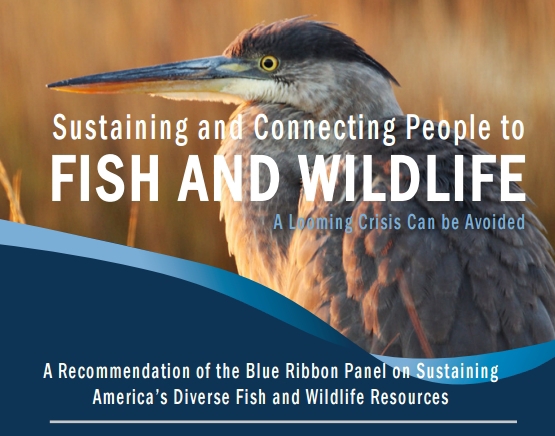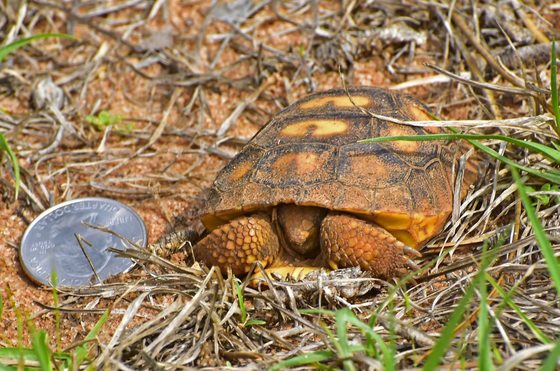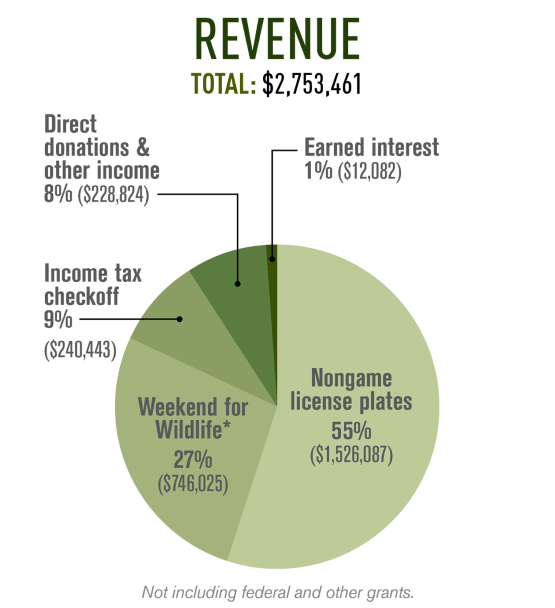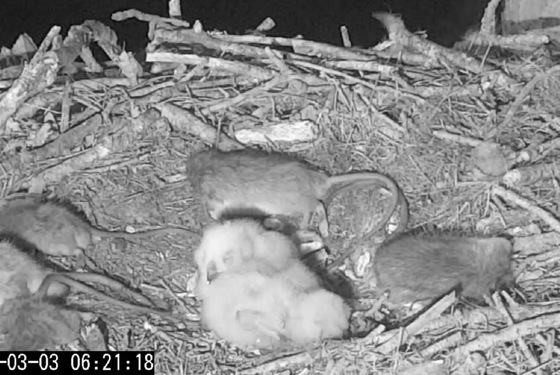IN THIS ISSUE
- A new way to fund nongame work nationwide.
- Choosing the right binoculars for you.
- Why Georgians are key to conserving wildlife.
 'WE NEED TO START DOWN A NEW PATH'
A group of energy, business and conservation leaders said last week the best way to meet America’s growing endangered species problem is to redirect $1.3 billion a year from energy and mineral development on federal lands and waters to state-based wildlife conservation.
The recommendation from the Blue Ribbon Panel on Sustaining America’s Diverse Fish & Wildlife Resources answers what its report calls a “looming crisis:” the addition of possibly thousands of species under the federal Endangered Species Act. Nearly 1,600 are listed as threatened or endangered.
Former Wyoming Gov. David Freudenthal, co-chair of the national panel, said much is at stake “if we don’t act soon.” “For every species that is thriving in our country, hundreds of species are in decline. We need to start down a new path where we invest proactively in conservation rather than reactively.”
Formed in 2014 by the Association of Fish & Wildlife Agencies, the panel includes leaders varying from outdoor businesses to energy industries, sportsmen’s groups and universities. Members explored funding, policy options and nongame wildlife needs. “Thousands of species of birds, mammals, fish, frogs, turtles and insects have been slipping through the cracks for decades,” says the report released.
Federal funding for states to conserve wildlife not fished for or hunted mostly comes from State and Tribal Wildlife Grants, budgeted at $50 million to $60 million and regularly targeted for cuts. Georgia received $1.21 million last year.
BETTER FOR WILDLIFE, BETTER FOR PEOPLE
According to the report, dedicating part of the $10 billion-plus collected from energy and mineral development to the unfunded Wildlife Conservation Restoration Program could reap mega-benefits:
- Providing needed funds for state fish and wildlife agencies to conserve some 12,000 high-priority species, as identified in State Wildlife Action Plans.
- Avoiding taxpayer costs and red tape created when species are federally listed. (The number of species petitioned for listing has increased by 1,000 percent in less than a decade.)
- Sustaining the country's natural infrastructure, which enriches humans in ways including pollination, water purification, recreation and food production.
- Supporting the U.S. economy – fish and wildlife populations are key to a $646 billion outdoor recreation economy and 6.1 million jobs – and citizens' quality of life, strengthening the conservation and outreach needed to keep people connected with nature.
Bass Pro Shops founder John Morris, who chaired the panel with Freudenthal, said redirecting the energy and mineral revenues to states for conservation is a logical solution. “It is now up to our leaders in Congress to move this concept forward.”
Read the summary report.
Below: Public is key in conserving Georgia wildlife.
Back to top.
 Roof prism (left) and porro prism binoculars. (Terry W. Johnson)
By TERRY W. JOHNSON
Beyond a shadow of a doubt, the one piece of equipment that can have the greatest impact on your enjoyment of your backyard neighbors is a fine pair of binoculars.
Since all binoculars look pretty much the same, it’s easy to assume they all perform in a similar manner. But I learned years ago that’s not the case. Then, I was using binoculars I bought for something like $29.95. I took them hunting, wildlife watching, on vacations. As far as I was concerned, the images I saw through them were as sharp as I could expect.
That belief was shattered when I took a college course in ornithology. Our first field trip was during spring warbler migration. I struggled to see the field marks on the small colorful birds flitting through treetops in the dim, early morning light. When I told the professor, he asked for my binoculars, peered through them and said with a smile, “Son, try mine.”
When I looked through his well-crafted binoculars, I exclaimed, “I can’t believe it!” The birds appeared brighter, more clear and three-dimensional.
If you aren’t satisfied with the binoculars you have, or you’re buying your first pair, here are a few tips that will help you choose the pair that is right for your needs. ...
Read the rest of Terry's column to guide your binoc search!
Terry W. Johnson is a former Nongame program manager with the Wildlife Resources Division and executive director of TERN, the Nongame Conservation Section’s friends group. “Out my backdoor” library.
Back to top.
 Juvenile gopher tortoise (Nate Thomas/DNR)
You may know that Georgia DNR’s Nongame Conservation Section is charged with conserving the state's nongame wildlife. That includes endangered and other native animals not legally fished for or hunted, rare plants and natural habitats.
But what you may not know is this work is paid for mostly through grants, fundraisers and direct donations. Contributions go into the Georgia Nongame Wildlife Conservation Fund, created by state law to conserve nongame and habitats.
The pie chart below shows Nongame Wildlife Fund revenue sources in fiscal 2015.
Clearly,
sales and renewals of eagle and hummingbird license plates are vital.
So is what’s called the Give Wildlife a Chance state income tax
checkoff.
And while Nongame
Conservation received some state funds in fiscal year 2016, a first
in decades, the funds make up less than 5 percent of the agency’s budget for wildlife conservation programs.
How
can you help restore and protect populations of wildlife such as bald
eagles and gopher tortoises, rare plants like monkeyface
orchids and critical habitats such as longleaf pine savannas?
- Upgrade to an eagle or hummingbird license plate, only $25 more than a standard tag.
- Donate through the Wildlife Conservation Fund checkoff when filing your 2015 taxes.
- Learn more about what Nongame Conservation does and how you can help support this work.
Also,
as noted above in this issue's lead article about the Blue Ribbon
panel, the need for broader funding to conserve nongame species isn’t
just a challenge for Georgia.
Conserving
wildlife and their habitats enriches our quality of life, helps keep
our waters clean and forests healthy, and strengthens our economy – now
and for the next generations of Georgians.
Now you know.
Learn more in Nongame Conservation's annual report.
Back to top.

A $2,500 reward is offered for information leading to a conviction in the shooting of a mature bald eagle found dead in northwest Georgia’s Polk County last month. Anyone with information can call U.S. Fish and Wildlife Service Special Agent Brian Roland, (404) 763-7959, or the Georgia DNR Ranger Hotline, (800) 241-4113.
Young birders have until only March 31 to sign up for DNR’s 2016 Youth Birding Competition. Set for 5 p.m. April 22 through 5 p.m. April 23, the free birdathon will have kindergarteners through high school seniors scrambling statewide to identify the most bird species and report them at Charlie Elliott Wildlife Center before the event-ending banquet.
Florida’s manatee population – the source of manatees that move into Georgia in spring and summer – is going strong, according to annual aerial surveys. The Florida Fish and Wildlife Conservation Commission reported a preliminary count of 6,250 manatees statewide and 3,292 on the east coast, similar to last year’s state total of 6,063 and only the second year on record the count of these endangered mammals has topped 6,000. Photos.
Rattlers or wild chickens? Visitors can find both plus plenty of entertainment and education in these soon-coming events – the Rattlesnake and Wildlife Festival March 12-13 near Claxton and Fitzgerald’s Wild Chicken Festival March 18-19. Both south Georgia festivals have transitioned and grown after abandoning rattlesnake roundup formats that included wild-caught rattlers.
 The great-horned owl nest at The Landings community on Skidaway Island has two owlets! And considering the screen grab above, the owlets (in the center) don't appear in immediate danger of starving. Watch 24/7 via The Landings, www.georgiawildlife.com and the Cornell Lab of Ornithology.
Wild plant enthusiasts will explore south Georgia’s diverse native flora during the Georgia Botanical Society’s annual Spring Wildflower Pilgrimage, April 15-17 in Valdosta. The 47th annual pilgrimage will include field trips to places such as Decatur County limestone cave and the Valdosta State University herbarium’s field station at a blackwater lake.
Wondering why leading young whooping cranes on migration with ultra-light aircraft has ended? In this FAQ, the Whooping Crane Eastern Partnership answers that and other questions about efforts to save the endangered birds.
New this turkey season, Georgia hunters will have to obtain a free harvest record each season, fill out the date and county before moving a gobbler they’ve killed, and complete the reporting process through Georgia Game Check within 72 hours of bagging the bird. Learn more and download the helpful Georgia Outdoors app.
Names: DNR fisheries technician II David Tannehill has been named Fishery Worker of the Year by the Georgia Chapter of the American Fisheries Society. Tannehill, based at the Fort Valley office, “is a model team player, always bringing his best to whatever task he sets out to do,” said Steve Schleiger, fisheries region supervisor. Wildlife Resources Division leaders, including Assistant Director Mark Whitney and Nongame Conservation Section Chief Dr. Jon Ambrose, met with lawmakers and their staff in D.C. this week to discuss funding for nongame conservation, all part of the annual Teaming With Wildlife Fly-in.
COMING UP:
March 12-13 – 49th annual Claxton Rattlesnake & Wildlife Festival, Hagan
March 18-19 – Fitzgerald Wild Chicken Festival, downtown Fitzgerald
April 15-17 – Georgia Botanical Society Spring Wildflower Pilgrimage, Valdosta (banquet at Valdosta State University Center)
April 22-23 – Georgia Youth Birding Competition. Finish and banquet at Charlie Elliott Wildlife Center, Mansfield.
May 7 – JAKES Day, Charlie Elliott Wildlife Center, Mansfield
May 16-18 – Longleaf Academy: Longleaf 101 (The Longleaf Alliance), Ft. Stewart, Hinesville
Nov. 1-4 – 11th biennial Longleaf Conference, The Longleaf Alliance, Savannah
WHAT YOU MISSED...
in the last Georgia Wild:
- Another golden eagle tracked in Georgia.
- Searching for spotted turtles.
- Our oldest-known oystercatcher.
Back to top.
(+ video) "Biologists predict 95 percent decline in Georgia bats (from white-nose syndrome)," WSB-TV (Channel 2, Atlanta)
"Panel proposes $1.3 billion wildlife management plan," New Jersey Herald
"Reward offered for information in killing of bald eagle in Polk County," WMGT-TV (NBC 41, Macon) and others, including Atlanta Journal-Constitution.
"Agreement intends to protect a fish reduced to six Appalachian counties," SaportaReport
"Endangered species killed in Savannah dredging," Savannah Morning News
"Interior, drillers win high-stakes lizard lawsuit," E&E Publishing
"Trees vital to improving stream quality, UGA study finds," phys.org
"DNR's David Tannehill recognized by Georgia Chapter of the American Fisheries Society," AmmoLand
"Snakes in a park? Not as much trouble as you'd expect," Conservation Magazine (University of Washington)
"Sustainable Georgia: grow parks, solve problems (Georgia Legacy)," Georgia Trend
"For the love of native plants (Mimsie Lanier Center for Native Plant Studies dedication)," UGA
"Georgia angler lands rare golden trout," Field & Stream
"Jimmy Carter inducted into Georgia Hunting and Fishing Hall of Fame," The Augusta Chronicle
"Monarch butterfly migration rebounds, easing some fears," The New York Times
"The vulture's iron stomach," BirdNote
VIDEO
"Controlled burn at Sandy Creek Nature Center," Tommy Jordan
Back to top.
|